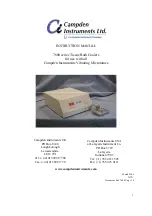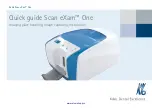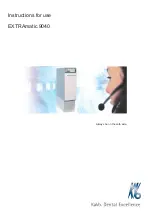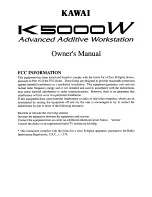
Chapter 1 Introduction
1-2
ADD-ONS
Depending upon the application, the following items may be added to the basic platform:
•
Internal Compressor.
Depending on the model, the internal compressor
provides up to 20 LPM of flow at pressures up to 50 psi. If the internal
compressor is not purchased, an external compressor or a “house” air supply can
be connected to the inlet bulkhead on the rear panel. The inlet bulkhead connects
the air supply to the coalescing filters. If the Model 1160 utilizes an external
pump or air supply and has a regenerative dryer installed, the air supply should be
able to produce at least 30 LPM of flow at a pressure of at least 60 psi. At lower
pressures, the drying efficiency will be compromised.
Inlet pressure must be
limited to 90 PSI when using an external air supply.
•
Scrubbers
. The Model 1160 can contain up to three scrubbing modules. When
multiple scrubbers are installed, they may be used in any combination to
simultaneously remove more than one pollutant, or multiple modules may be
filled with the same material to extend the time between service.
Note
. The
recommended order is, drierite, purafil, and charcoal. The following scrubbing
materials are available:
a)
Charcoal: Removes ozone (O
3
), sulfur dioxide (SO
2
), and non-
methane hydrocarbons.
b)
Purafil: Removes NO
x
c)
Drierite: Removes water vapor. It should be noted that this material is
not normally used without a regenerative dryer. Used alone it will
effectively reduce the amount of water vapor, but it may quickly
become saturated and increase the frequency of service.
•
Dryers.
If dry air is required, the Model 1160 may include either a membrane or
a regenerative dryer. For most applications, it is recommended that one of these
be used since the efficiency of adsorbents such as charcoal and Purafil may
decrease at high humidity levels.
Although the regenerative dryer provides a lower dew point than the membrane
dryer, it is more costly and requires higher airflow to operate. The membrane
dryer is suitable for many applications that do not require a dew point below 5
°
C.
The operation of the dryers is as follows:
a)
Membrane:
The membrane dryer uses non-porous, hollow fiber
membranes. Compressed air is conducted inside the membranes.
Water vapor molecules permeate the wall of the membrane, leaving
the oxygen and nitrogen molecules to exit the outlet as dry air. A
small amount of dry air is routed to the outside of the membrane fibers
to sweep away the permeated water vapor through a purge valve.
Содержание 1160
Страница 4: ......
Страница 8: ......
Страница 10: ......
Страница 22: ...Chapter 2 Installation 2 6 Figure 2 4 Scrubber Assembly Component P N 104558 00 P N 104558 00 P N 104557 00 ...
Страница 30: ...Chapter 4 Maintenance 4 2 Figure 4 1 Scrubber Parts List ...
Страница 34: ......
Страница 46: ...C 2 ...
Страница 47: ...C 3 ...
Страница 48: ...C 4 ...
Страница 49: ...C 5 ...
Страница 50: ...C 6 ...
Страница 51: ...C 7 ...
Страница 52: ...C 8 ...













































